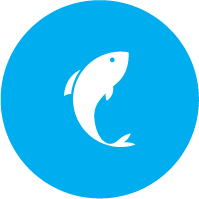WHAT IS IMTA?
Integrated Multi-Trophic Aquaculture
The Integrated Multi-Trophic Aquaculture (IMTA) is acknowledged as a promising solution for the sustainable development of aquaculture.
IMTA farmers combine species that need supplemental feed such as fish, with “extractive” species. Extractive species use the organic and inorganic materials and by-products from the other species for their own growth. Extractive species can be primary producers (algae and plant species that transform inorganic nutrients into organic biomass) or secondary producers (those that use organic material from the water column or the seabed as food). The secondary producers can be either filter feeders (generally shellfish that sieve organic particles such as algae from the water column) or deposit feeders (organisms such as worms, sea urchins, sea cucumbers etc. that feed on organic material on or within the sediment). Extractive species act as living filters. The natural ability of these species to recycle the nutrients (or wastes) that are present in and around fish farms can help growers improve the environmental performance of their sites. In addition, the extractive species have commercial value as marketable products, providing extra economic benefits.
The IMTA concept is sometimes used in a strict sense: having the different trophic levels integrated in one farm or business, at the same site. However, trophic links in aquatic ecosystems can extend over a large spatial scale. Depending on the local hydrodynamics and the biogeochemical processes involved, spatial separation may be even beneficial. E.g. as the transformation from fish waste into nutrients takes time and if there is a residual current, the best location for a seaweed farm to optimally utilise these nutrients may not be in the immediate vicinity of the fish farm, but further downstream. Conversely, cultivation of different species at the same site may occur, without a direct trophic link between the crops, due to the economic benefit of co-location and being able to use a production site in all seasons and for multiple products at the same site. This type of co-location is perhaps a bit beyond the strict definition of IMTA, but still highly relevant for developing business cases for new forms and aquaculture. As aquaculture heads towards more organised spatial planning, IMTA will have to become a reality to optimise limited space.
Impaqt will enable a more efficient IMTA practice. First, at planning phase, the advanced IMTA model will allow select the optimal site and the optimal spatial configuration for various aquaculture components. Impacts and interactions will be specifically assessed at an ecosystem scale, rather than just at the scale of individual farms. Second, at operational phase, IMS will enable assess the current status and respond to production and environmental challenges timely at the scale of an IMTA farm









